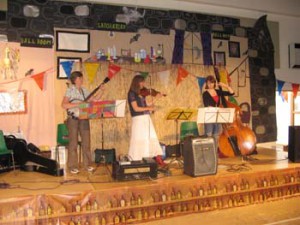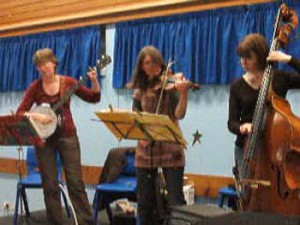How to run a barn dance or ceilidh
Barn dances are a fun and sociable form of dancing that mostly take place in informal places such as village halls, barns and wedding venues. They are very easy to organise. An average sized village hall is all you need to start with and then invite an audience and book a band and caller. The size of the audience will be dependent on the capacity of the hall that you have booked. Typically barn dances are organised for 60 to 100 dancers. The more dancers you have then the more opportunities there are for dancers to rest whilst other dancers dance.
Serving food
As a member of a barn dance band I have had plenty of experience of barn dance food, and refreshments typically range from hot suppers to cold ploughmans. Jacket potatoes with various fillings, burgers and salad and fish and chips are quite common fare at barn dances followed by homemade desserts. Licensing permitting organisers may choose to sell alcohol or invite dancers to bring their own drinks. The band will always welcome a drink and Hullabaloo barn danceband’s favourite drink at a dance is a good cup of tea!
Do we need to know how to dance?
The great think about barn dances and ceilidhs is that you can be a complete beginner and still dance every dance. The caller will explain the dance at the beginning whilst the dancers walk through the steps. After a quick recap the music will start and the caller will call the instructions as the dancers whisk through the dance to music. As the dancers become more familiar to the instructions then the dances may be made more complex and sometimes speeded up. The energy is amazing and the dances can become thrilling as you are carried away by the music. Dancers will typically start in sets of four to five couples. These can be long ways sets, square sets or circles. Most people were introduced to barn dancing as children, at school, in the form of country dancing and familiar dances might be the Gay Gordons,Virginia Reel, The Cumberland Square Eight (yes with the basket), Foula Reel and Strip the Willow.

Who’s in the band?
Barn dance bands are typically made up of a fiddle, bass and accordion. In recent times guitars, banjos, drums and flutes are all added to the mix. Hullabaloo barn dance and ceilidh band is made up of a fiddle, banjo and bass. The music played is a mixture of Scottish, Irish, English and sometimes American and mainland European tunes.
Hullabaloo Barn Dance and Ceilidh Band
Hullabaloo barn dance band has been playing for over fifteen years in the Reading, Berkshire and Kingston, Surrey area (we also play in Hampshire and Oxfordshire). We play for all types of events ranging from village socials and fetes, school fund-raising, corporate events, milestone birthdays, Scottish dancing groups, St Patrick’s Day and St Andrew’s Day events, anniversaries and weddings. We typically play for up to three hours including breaks and generally from around 8.00pm – 11.00pm. We would welcome the opportunity to play for your next event and look forward to your call.


